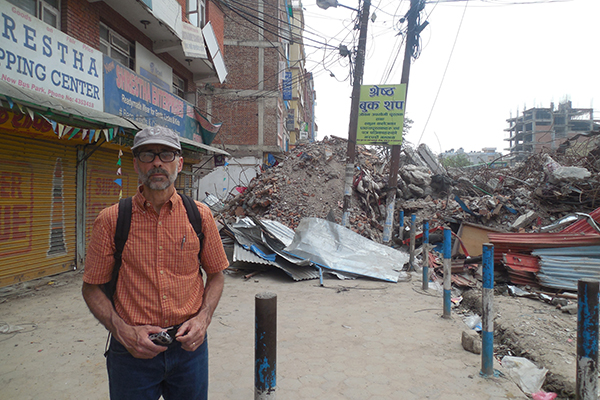
Sept. 21: Earthquake presentation
Disaster Research Center scientists to discuss their work in Nepal
11:25 a.m., Sept. 11, 2015--A team from the University of Delaware’s Disaster Research Center (DRC) that traveled to Nepal soon after that nation experienced massive earthquakes this spring will discuss its findings with the UD community at 10 a.m. on Monday, Sept. 21.
The presentation, which is free and open to the public, will be held in Room 102 Colburn Lab.
Research Stories
Chronic wounds
Prof. Heck's legacy
The researchers focused their work on various aspects of the social impact of the April 25 and May 12 earthquakes on local communities. They were on the ground in Nepal — in the capital, Kathmandu, and in some outlying villages — for two weeks in late May and early June, as residents were preparing for the coming monsoon season while still recovering from the devastation of the earthquakes.
“When we arrived, some areas looked almost OK, while others were still in very bad shape, with collapsed buildings and with victims likely still under the rubble,” said Samantha Penta, a doctoral student in sociology who examined issued of how the disaster affected medical decision-making. “The big concern when we were there was getting ready for the monsoons; everybody was very focused on that.”
Many people were sleeping in tents, some clustered in large camps and others squeezed into any site with available space. The DRC team found that the trauma of the earthquakes and aftershocks left many residents afraid to remain inside buildings at night for fear of additional collapses.
“We didn’t see anything too surprising, but it was overwhelming to see the extent of the damage,” said Daryl Yoder-Bontrager, a doctoral student in disaster science and management who studied the coordination of efforts among nongovernmental organizations. “Relief and recovery work gets done, but it doesn’t always get done smoothly or quickly.”
Overall, the researchers said, Nepal was relatively well prepared for the disaster, despite such national challenges as high poverty rates and an interim government.
“It’s a very seismically active region, so they recognized the risk,” Penta said. “It was a tremendous example of how meaningful preparedness can take place in spite of limited resources, and it really paid off. We found people who were real champions for preparedness.”
Each researcher had an area of focus, but also worked as part of the team, which included Manoj Suji, a graduate student from the Department of Anthropology and Sociology at Tribhuvan University of Nepal.
“We were looking at issues that overlapped in many ways,” said DRC postgraduate researcher Sarah DeYoung, whose focus was on the impact of the disaster on infant care and feeding and on women’s and children’s nutrition. She plans to return to Nepal in November for a follow-up study on conditions six months after the earthquake.
The team members are currently analyzing their data and preparing to publish results. The Sept. 21 presentation will provide an overview of their findings.
In addition to DeYoung, Penta and Yoder-Bontrager, the presentation will include researcher Rachel Davidson, professor of civil and environmental engineering at UD and a core faculty member with the DRC. She worked in Nepal with a separate team from the Earthquake Engineering Research Institute and studied the effects of the quake on infrastructure, including not just buildings but also such key services as water and power supplies and waste disposal capability.
Article by Ann Manser
Photo courtesy of Disaster Research Center








